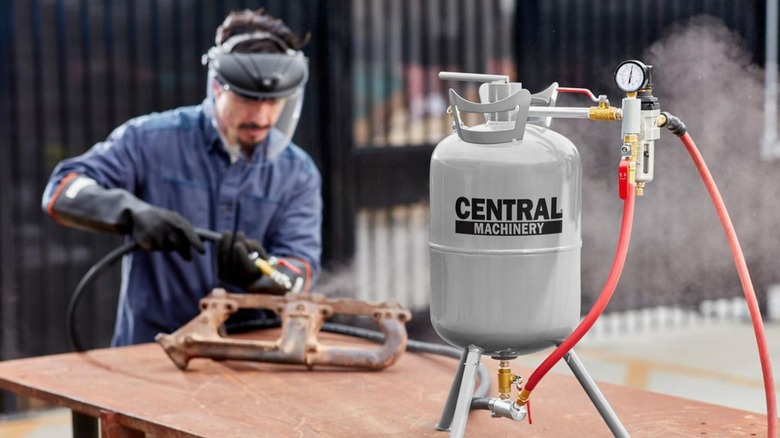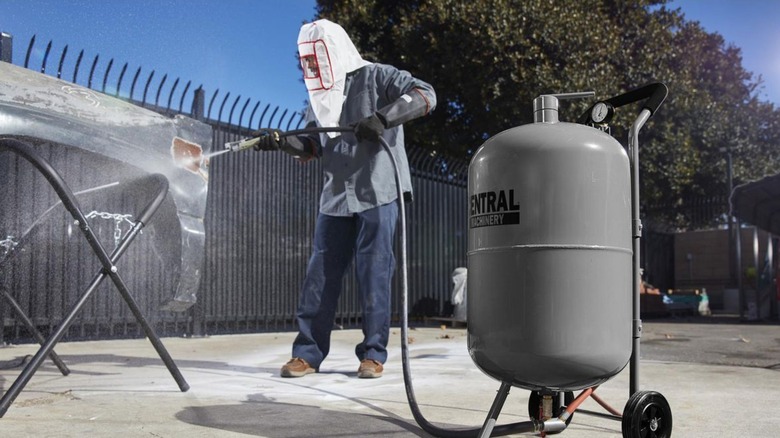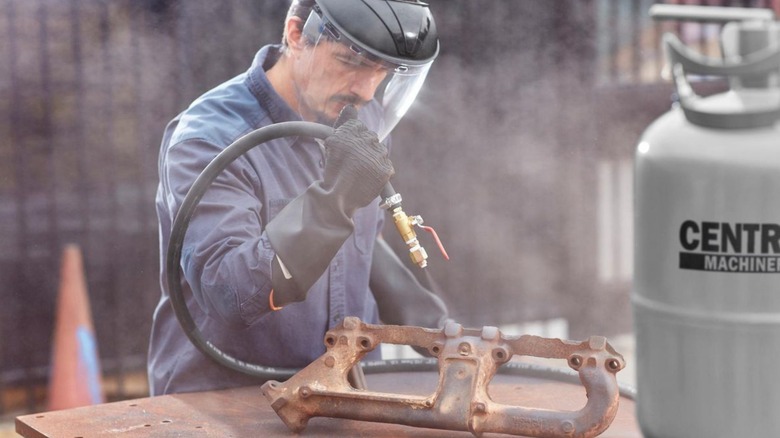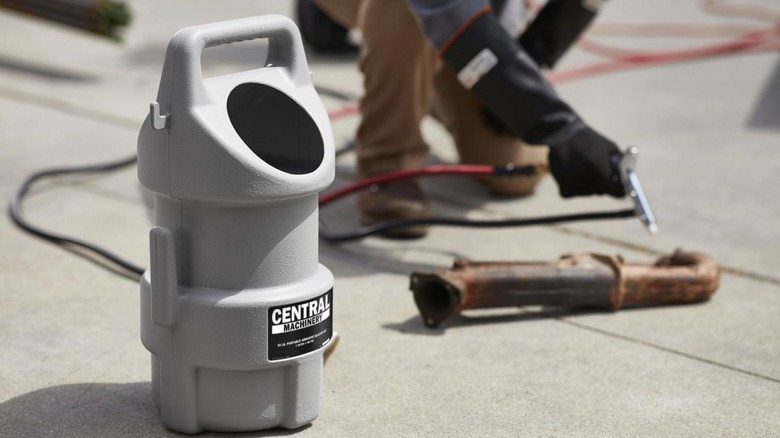3 Reasons You May Want A Harbor Freight Sandblaster For Your Classic Car Project
We may receive a commission on purchases made from links.
Restoring a classic car allows you to improve your mechanical skills, occupy your free time, and experience the satisfaction of bringing new life to an old vehicle. However, antique cars also come with their share of challenges, and one of the top mistakes people make when buying a classic car is failing to account for the work that needs to be done. Often, that work translates to hundreds of hours of tedious labor spent removing decades of rust, corrosion, and old paint. Not only is removing old paint and rust labor-intensive and boring, but it can also be dangerous if you don't use the proper equipment, like respirators and coveralls.
Fortunately, there are some ways to make this task less odious. You can use various different types of power grinders, but although grinders are excellent for removing paint and rust, they're not ideal for removing those materials from every object. Sometimes, you'll need to clean parts that are oddly-shaped or too small for a grinder. In those cases, a sandblaster may be the best tool for the job.
These powerful tools allow us to blast fine, abrasive particles at various surfaces to remove things like paint, rust, corrosion, and mold. One of the best places to shop for these devices is Harbor Freight, the budget-oriented tool store famous among tradespeople and DIYers. If you're curious about learning more about Harbor Freight's sandblasters and why you might want one for your classic car project, we've got you covered. As a former professional mechanic and a lifelong car enthusiast, I'll break it down for you. So, let's dive in and explore all the reasons why you may want a Harbor Freight sandblaster for your next vintage vehicle restoration project.
Remove old paint and rust
One of the primary uses for sandblasters is to remove things like old paint and rust from various surfaces, including vintage car body panels and frames. Sandblasters work by using compressed air to blow large amounts of abrasives — like aluminum oxide, walnut shells, soda, and small glass beads — over surfaces at incredibly high speeds. Depending on the type of abrasive, sandblasters can strip off superficial layers of material like corrosion and mold and polish surfaces for a finished look.
When it comes to classic car projects, sandblasters are extremely valuable. Not only do vintage vehicles tend to have a lot of rust and corrosion, but it's also common for older vehicles to have many layers of various paint jobs and a lot of other caked-on mess. A sandblaster can be a great way to take care of that old crud. As mentioned, you can use a power grinder. However, power grinders are ideal for large, moderately-flat surfaces. They can do a wonderful job on body panels, but they aren't ideal for harder-to-reach parts and smaller surfaces.
Additionally, power grinders require you to operate them by hand, which can be extremely tiring after a while. If you're tackling a complete restoration project using a power grinder, you're likely to end up exhausted after a short period of working the tool. Instead, sandblasters allow you to direct a stream of abrasive at a surface, similar to the way power washers work, resulting in a much less-strenuous process and a more-enjoyable restoration experience.
Clean small and oddly-shaped parts
We've already mentioned that sandblasters are excellent tools for classic car projects due to the way that they're able to tackle a variety of jobs, including removing material from small, hard-to-reach, or irregularly-shaped parts. That's incredibly important, as vintage vehicles are packed with components that a standard power grinder just can't reach, and it's worth expanding on this with a few examples.
While classic cars have a lot of large body panels and other bigger parts, they also have a massive amount of smaller components. If you're working on a restoration project, you can't skip those tiny parts — each one is a vital piece of the puzzle, and the car won't be complete unless you restore all of it. Many of those small parts are located inside the vehicle's interior. Things like dashboard buttons, shift levers, and seats are frequently made with metal, and over time, those parts can develop rust and corrosion. While a power grinder may be unable to hit all those surfaces, a sandblaster can tackle the task with ease. You can opt for an abrasive blast cabinet for smaller parts, or you can attach a blasting nozzle to your air compressor for larger components or smaller parts that you don't feel like removing from the vehicle.
Finally, it's also common to encounter components with odd shapes, making it difficult for a standard grinder to hit every surface. Things like brackets, exhaust tubing, and frame rails aren't simple flat pieces of metal. They may feature 90-degree angles or curves that make grinders less efficient, and a sandblaster may be your best bet for knocking out these projects.
Harbor Freight's sandblasters are relatively affordable
As mentioned, the two primary reasons you may want a sandblaster for your classic car project are to remove large amounts of paint and rust and to clean small and irregularly-shaped parts. However, there's another reason you may want a Harbor Freight sandblaster specifically: they're more affordable than many competitor models.
A basic Central Machinery 18 ounce Portable Abrasive Blaster Gun Kit costs $29.99 at Harbor Freight. That's about $50 cheaper than one of the most-popular and top-rated nozzles on the market right now: the Lematec AS118. While the Harbor Freight product is slightly less powerful than the more expensive tool, it remains a robust and efficient device for various automotive projects, and it's very well-rated by Harbor Freight customers.
A basic blaster nozzle isn't your only option, though. Harbor Freight sells everything from heavy-duty blaster cabinets to complete portable blaster kits, and even various types of abrasive material and safety gear. Stationary blaster cabinets start as low as $209 — or even cheaper if you're an Inside Track Club member — and top out around $1,1000. Portable kits, on the other hand, range in price from $34.99 to over $100. Compared to other top names, Harbor Freight's sandblasters represent modest savings. While saving between $20 and $100 may not seem like much, every cent counts while working on a custom car project. Even small savings can make the difference between completing your build on time and waiting for months to acquire that final part.



